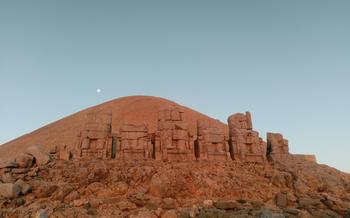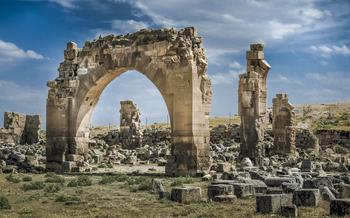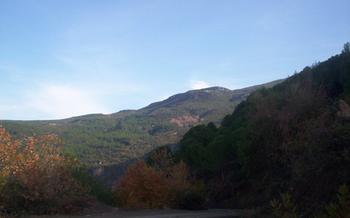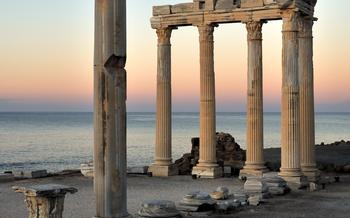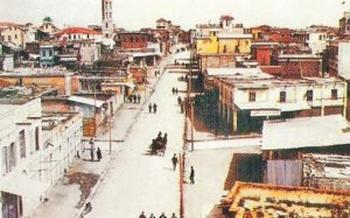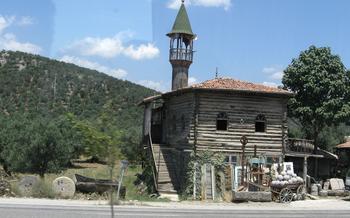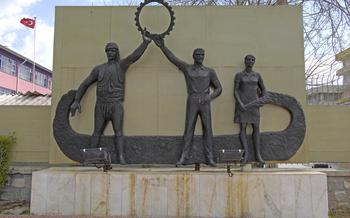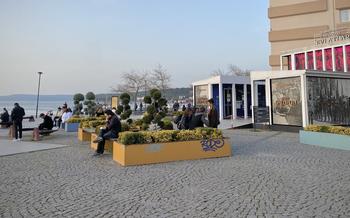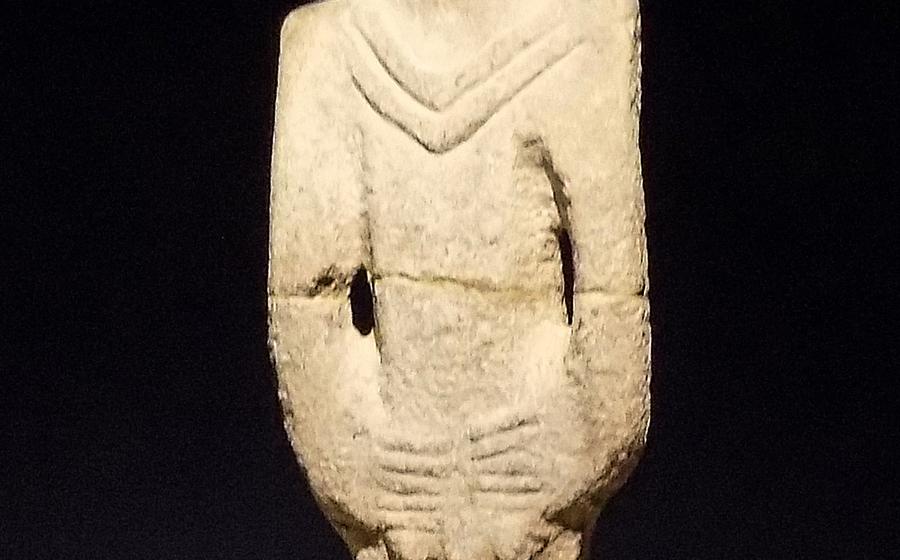
Nemrut Dağı (Mount Nemrut)
- About Mount Nemrut
- The Legendary King Antiochus I
- UNESCO World Heritage Site
- The Royal Tomb
- The Gigantic Statues
- The Sacred Precinct
- The Lion Statues
- The Eagle Statues
- The Western Terrace
- The Eastern Terrace
- The Causeway
- The Mausoleum
- The Tumulus
- The Panorama
- Insider Tip
About Mount Nemrut
Mount Nemrut, a colossal mountain in southeastern Turkey, stands as a testament to the ingenuity and ambition of ancient civilizations. Constructed by King Antiochus I of the Commagene Kingdom in the 1st century BC, this 70-meter-high artificial mound is an awe-inspiring sight that has captivated visitors for centuries. The mountain, situated in the heart of the ancient Commagene Kingdom, served as a monumental tomb and a sacred site for the worship of the royal family. With its stunning location atop a remote mountain peak, Mount Nemrut offers a breathtaking panorama of the surrounding landscape, making it one of Turkey's most iconic landmarks and a must-visit destination for history enthusiasts and nature lovers alike.
The Legendary King Antiochus I
King Antiochus I, also known as Antiochus Theos, was a remarkable figure in the history of the ancient Near East. His reign marked a period of prosperity and cultural flourishing for his kingdom.
Antiochus I's Heroic Deeds
King Antiochus I was a skilled military leader who successfully defended his kingdom against various threats. He is particularly renowned for his victory over the Parthians, a powerful nomadic people from Central Asia. This victory ensured the stability of his kingdom and secured its borders.
Legends About King Antiochus I
Numerous legends and tales have been woven around the life of King Antiochus I, attesting to his enduring legacy. One popular legend tells of his divine ancestry, claiming that he was the son of the Greek god Apollo and a mortal woman. Another legend portrays him as a wise and just ruler who was deeply loved by his people.
Genealogy of King Antiochus I
King Antiochus I belonged to the Seleucid dynasty, a Hellenistic dynasty founded by Seleucus I Nicator, one of Alexander the Great's generals. He was the son of Antiochus II Theos and Laodice I, and his lineage can be traced back to the illustrious Macedonian royal family.
UNESCO World Heritage Site
Mount Nemrut was declared a UNESCO World Heritage Site in 1987 for its outstanding universal value. The criteria for being a UNESCO World Heritage Site are:
Cultural heritage: Mount Nemrut is a unique example of a Hellenistic royal tomb and sanctuary. It is also a testament to the power and influence of the Kingdom of Commagene. Natural heritage: Mount Nemrut is located in a stunning natural setting, with panoramic views of the surrounding mountains and valleys. Threatened heritage: Mount Nemrut is a threatened heritage site due to the effects of climate change, pollution, and tourism.
UNESCO's recognition of Mount Nemrut as a World Heritage Site has helped to raise awareness of the importance of this site and to promote its conservation. It has also made Mount Nemrut a more popular tourist destination, which has brought economic benefits to the local community.
The Royal Tomb
The royal tomb of King Antiochus I is the centerpiece of Mount Nemrut. It is a massive structure located at the summit of the mountain, beneath the colossal statues. The tomb is constructed of large blocks of stone and features a vaulted ceiling. Inside the tomb, there is a sarcophagus, which is believed to contain the remains of King Antiochus I.
The tomb is of great historical significance, as it provides valuable insights into the life and reign of King Antiochus I. The tomb also contains a number of valuable artifacts, including jewelry, pottery, and weapons. These artifacts provide further evidence of the wealth and power of the Kingdom of Commagene.
Exploring the royal tomb is a challenging but rewarding experience. Visitors must climb a steep path to reach the tomb, and the interior of the tomb is dark and cramped. However, the rewards of exploring the tomb are great. Visitors will be able to see the sarcophagus of King Antiochus I, as well as the other artifacts that have been found in the tomb.
The tomb is a must-see for anyone interested in the history of the Kingdom of Commagene. It is a reminder of the power and wealth of this ancient kingdom, and it provides a glimpse into the life of one of its most famous rulers.
The Gigantic Statues
Towering over the sacred precinct of Mount Nemrut are the colossal statues that have become iconic symbols of this ancient site. These awe-inspiring sculptures, standing tall at an impressive 8-9 meters, were meticulously crafted from limestone, a testament to the engineering prowess of the ancient civilization.
The statues depict various figures, including King Antiochus I himself, Greek and Persian deities, and mythical creatures. Each statue exudes a sense of majesty and divinity, befitting their role as guardians of the sacred precinct. The intricate details and lifelike expressions add to their allure, captivating visitors with their timeless beauty.
The statues on the eastern and western terraces are particularly noteworthy for their distinct features. On the eastern terrace, the statues are adorned with crowns and elaborate headdresses, symbolizing their divine status. In contrast, the western terrace statues are depicted wearing helmets and armor, representing their earthly power and military prowess.
The symbolism behind the statues is profound and multifaceted. They embody the fusion of Greek and Persian cultural influences that characterized the Hellenistic period. The Greek gods, such as Zeus and Apollo, are depicted alongside Persian deities like Mithras and Ahura Mazda, reflecting the religious syncretism prevalent at the time.
These colossal statues are not merely decorative elements; they serve as silent witnesses to the grandeur and ambition of King Antiochus I. Through their stoic presence, they continue to captivate and inspire visitors, offering a glimpse into the rich history and legacy of this ancient civilization.
The Sacred Precinct
The sacred precinct is the heart of Mount Nemrut. It is a large, open area surrounded by a wall. Inside the precinct are several structures, including the royal tomb, the Western and Eastern Terraces, and the causeway. The sacred precinct was used for religious ceremonies and rituals.
One of the most important structures in the sacred precinct is the royal tomb. This is where the remains of King Antiochus I are buried. The tomb is a large, mound-like structure that is surrounded by a ring of columns. The columns are decorated with reliefs depicting scenes from the life of King Antiochus I.
The Western and Eastern Terraces are two large platforms that are located to the west and east of the royal tomb. The terraces are lined with statues of gods and goddesses. The statues are all carved from a single block of stone and are over 8 meters tall.
The causeway is a long, stone-paved road that leads from the base of the mountain to the sacred precinct. The causeway is flanked by a wall of carved stones. The stones are decorated with reliefs depicting scenes from the life of King Antiochus I.
The sacred precinct of Mount Nemrut is a powerful and awe-inspiring place. It is a reminder of the power and influence of the ancient kingdom of Commagene.
The Lion Statues
Lions, Guardians of the Sacred Precinct
In the sacred precinct, flanking the colossal statues and tomb of Antiochus I, stand two majestic lion statues as silent guardians. These awe-inspiring sculptures, carved from immense blocks of limestone, embody the strength, power, and pride of the Commagene Kingdom. Their imposing presence adds to the mystique of Mount Nemrut, making them a prominent symbol of this ancient site.
The lion statues, positioned at the entrance of the royal tomb, serve as symbolic protectors of Antiochus I's final resting place. Their fierce expressions, muscular bodies, and intricate details showcase the exceptional craftsmanship of the ancient artisans. The lions, with their piercing gaze and commanding presence, seem to warn against any who dare to disturb the sacred grounds.
Beyond their symbolic role, the lion statues hold deep cultural and religious significance. In ancient Near Eastern mythology, lions were often associated with royalty, strength, and divine protection. Their presence at Mount Nemrut reflects the importance and prestige of the Commagene Kingdom, as well as the belief in a higher power watching over the realm.
Preserving these magnificent lion statues poses significant challenges due to their age and exposure to the elements. The harsh weather conditions, including extreme temperatures and strong winds, have caused some erosion and damage to the statues over time. Conservation efforts are ongoing to ensure their longevity and preserve them for future generations to appreciate.
The Eagle Statues
Among the awe-inspiring sculptures of Mount Nemrut, the eagle statues stand out as symbols of strength and power. These majestic creatures, with their wings outstretched as if ready to take flight, guard the sacred precinct and symbolize the divine protection of the gods.
The eagles, carved from massive blocks of limestone, are positioned atop massive pillars that line the terraces. Their piercing gazes seem to survey the vast landscape, watching over the ancient kingdom and its people. The intricate details of their feathers, talons, and beaks showcase the exceptional craftsmanship of the ancient sculptors.
The eagles hold a profound religious significance in the culture of the Kingdom of Commagene. They were considered sacred animals, representing the power of the sun god Mithras and the connection between the earthly and heavenly realms. Their presence at Mount Nemrut reflects the deep spiritual beliefs of King Antiochus I and his desire to create a lasting legacy that would honor the gods and ensure the prosperity of his kingdom.
However, the eagles have not remained unscathed by the ravages of time and natural elements. Over the centuries, they have faced the relentless force of wind, rain, and earthquakes, resulting in some damage to their intricate features. Despite these challenges, the eagles continue to stand tall, a testament to the enduring legacy of Mount Nemrut and its significance as a UNESCO World Heritage Site.
Preserving the eagle statues is an ongoing challenge for archaeologists and conservationists. The remote location of Mount Nemrut and the harsh weather conditions make it difficult to implement restoration and maintenance efforts. Nevertheless, ongoing research and monitoring are being conducted to ensure that these iconic symbols of power and divinity continue to inspire and captivate visitors for generations to come.
The Western Terrace
The Western Terrace is a large, open area located on the western side of Mount Nemrut. It is the largest of the three terraces on the mountain and is home to some of the most impressive remains of the ancient city.
The Western Terrace is dominated by a large, rectangular platform that is thought to have been used for religious ceremonies. The platform is surrounded by a series of smaller platforms and chambers, which were probably used by priests and other religious officials.
The Western Terrace also features a number of impressive statues, including a colossal statue of King Antiochus I. The statue is over 8 meters tall and is carved from a single block of stone. It is one of the most iconic images of Mount Nemrut and is a popular tourist attraction.
The Western Terrace offers stunning views of the surrounding countryside. On a clear day, it is possible to see for miles in every direction. The terrace is a popular spot for sunrise and sunset viewing, as the colors of the sky are reflected in the surrounding mountains.
Challenges in accessing the Western Terrace:
The Western Terrace is located at an altitude of over 2,000 meters. The climb to the terrace is steep and challenging, and it can take several hours. The path to the terrace is also uneven and rocky, so it is important to wear sturdy shoes.
The Western Terrace is exposed to the elements, so it is important to be prepared for extreme weather conditions. In the summer, the sun can be very hot, and it is important to drink plenty of water and wear sunscreen. In the winter, the temperature can drop below freezing, and it is important to wear warm clothing.
The Eastern Terrace
The Eastern Terrace is a large, flat area located on the eastern side of Mount Nemrut. It is home to several important structures, including the Royal Tomb of King Antiochus I, the Lion Statues, and the Eagle Statues.
The Royal Tomb is a large, rectangular structure that is located in the center of the Eastern Terrace. It is believed to be the burial place of King Antiochus I. The tomb is surrounded by a number of smaller chambers, which are thought to have been used by the king's family and entourage.
The Lion Statues are located on either side of the Royal Tomb. They are each about 8 meters tall and weigh several tons. The lions are depicted in a roaring pose, and they are believed to be symbols of strength and power.
The Eagle Statues are located at the eastern end of the Eastern Terrace. They are each about 5 meters tall and weigh several tons. The eagles are depicted with their wings spread out, and they are believed to be symbols of freedom and majesty.
The Eastern Terrace is a significant part of Mount Nemrut, and it is a popular destination for visitors. The terrace offers stunning views of the surrounding landscape, and it is a great place to learn about the history of the ancient kingdom of Commagene.
Challenges in Exploring the Eastern Terrace
The Eastern Terrace is a challenging place to explore. The terrace is located at an altitude of over 2,000 meters, and the air can be thin and cold. The terrace is also exposed to the elements, and it can be windy and rainy.
Visitors to the Eastern Terrace should be prepared for the challenges of the environment. They should wear warm clothing and sturdy shoes. They should also bring water and snacks, as there are no facilities on the terrace.
Visitors to the Eastern Terrace should also be aware of the potential for altitude sickness. Symptoms of altitude sickness can include headache, nausea, and vomiting. If you experience any of these symptoms, you should descend to a lower altitude immediately.
The Causeway
The causeway of Mount Nemrut is an impressive ancient road that leads from the base of the mountain to the summit. It is approximately 2 kilometers long and 8 meters wide, and is constructed of large stone blocks. The causeway is believed to have been built by King Antiochus I in the 1st century BC, and it served as the main route for pilgrims and visitors to the royal tomb and sacred precinct.
Today, the causeway is still used by visitors to Mount Nemrut, and it offers stunning views of the surrounding landscape. However, it is important to note that the causeway is steep and uneven in places, and it can be challenging to traverse, especially in bad weather. Visitors should wear sturdy shoes and be prepared for a challenging hike.
There are a few challenges associated with traversing the causeway. Firstly, the causeway is steep and uneven in places, and it can be difficult to walk on. Secondly, the causeway is exposed to the elements, and it can be hot and dusty in the summer, and cold and icy in the winter. Thirdly, the causeway is often crowded with tourists, and it can be difficult to find a quiet spot to enjoy the views.
The Mausoleum
The mausoleum of Mount Nemrut is a large, stone-built structure that is believed to be the tomb of King Antiochus I. It is located on the summit of the mountain, and is surrounded by a circular wall. The mausoleum is about 50 meters in diameter, and is constructed of large blocks of stone. The entrance to the mausoleum is on the east side, and is flanked by two large statues of lions.
The interior of the mausoleum is divided into two chambers. The first chamber is a large, open room that is lined with niches. These niches are believed to have contained statues of the gods and goddesses of the Commagene kingdom. The second chamber is smaller, and is believed to have been the burial chamber of King Antiochus I. This chamber contains a large, stone sarcophagus, which is believed to hold the remains of the king.
The mausoleum of Mount Nemrut is a significant archaeological site, and is one of the most important examples of Hellenistic architecture in Turkey. It is also a popular tourist destination, and is visited by thousands of people each year.
The Tumulus
The tumulus is an artificial mound that was constructed on top of Mount Nemrut. It is believed to contain the tomb of King Antiochus I. The tumulus is made of stones and soil, and it is about 50 meters high and 150 meters in diameter. The tumulus was built by the people of Commagene as a monument to their king.
The tumulus has been extensively excavated by archaeologists, but the tomb of King Antiochus I has not yet been found. Despite this, the tumulus remains an important historical site, and it is one of the most popular tourist attractions in Şanlıurfa.
Visitors to Mount Nemrut can climb to the top of the tumulus to enjoy stunning views of the surrounding countryside. The tumulus is also a popular spot for sunrise and sunset viewing.
Exploring the tumulus can be a challenging task, as the terrain is steep and uneven. However, the rewards are worth the effort, as the tumulus offers a unique perspective on the ancient history of Commagene.
The Panorama
A Breathtaking Vista Unveiled
Prepare yourself for an awe-inspiring spectacle as you ascend Mount Nemrut. The panorama that awaits you is guaranteed to leave you breathless. The vast expanse of the surrounding landscape unfolds before your eyes, stretching as far as the horizon. From this vantage point, you can admire the majestic peaks of the Taurus Mountains, their summits capped with snow, creating a dramatic contrast against the blue sky.
The sprawling plains below, dotted with villages and agricultural fields, paint a picture of rural tranquility. As the sun casts its golden rays, the landscape transforms into a canvas of vibrant colors, creating a mesmerizing spectacle. The interplay of light and shadow adds depth and dimension to the scene, making each moment a unique and unforgettable experience.
Tips for an Unforgettable Visit
To fully appreciate the splendor of the panorama, consider visiting Mount Nemrut during the early morning hours. As the sun rises, the landscape is bathed in a warm, golden glow, creating an ethereal atmosphere. The changing colors of the sky, from deep purple to vibrant orange, add to the magic of the experience.
For those seeking a more immersive encounter, consider spending a night atop the mountain. Camping or staying in one of the nearby guesthouses allows you to witness the panorama under the starry sky, a truly unforgettable experience. The celestial bodies above, combined with the panoramic vista, create a sense of awe and wonder that will stay with you long after your visit.
Insider Tip
How to get to Mount Nemrut?
Mount Nemrut is located in southeastern Turkey, about 80 kilometers north of the city of Şanlıurfa. The easiest way to get to Mount Nemrut is to take a tour from Şanlıurfa. Tours typically depart early in the morning and return in the evening. It is also possible to rent a car and drive to Mount Nemrut, but the roads are winding and can be difficult to navigate.
Where to stay near Mount Nemrut?
There are a few hotels and guesthouses located near Mount Nemrut. The closest hotel is the Nemrut Dağı Hotel, which is located about 5 kilometers from the summit. Other options include the Karadut Hotel and the Şanlıurfa Hilton.
What to pack for a trip to Mount Nemrut?
Be sure to pack comfortable shoes, as you will be doing a lot of walking. You should also pack a hat, sunglasses, and sunscreen to protect yourself from the sun. If you are visiting Mount Nemrut in the winter, be sure to pack warm clothing, as the temperatures can drop below freezing.
What are the best tours of Mount Nemrut?
There are a number of different tours of Mount Nemrut available. Some tours focus on the history of the site, while others focus on the archaeology. There are also tours that offer hiking and camping opportunities. When choosing a tour, be sure to choose one that fits your interests and budget.
